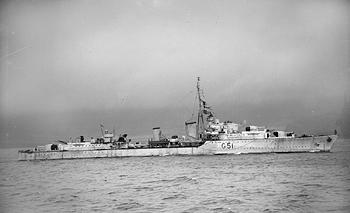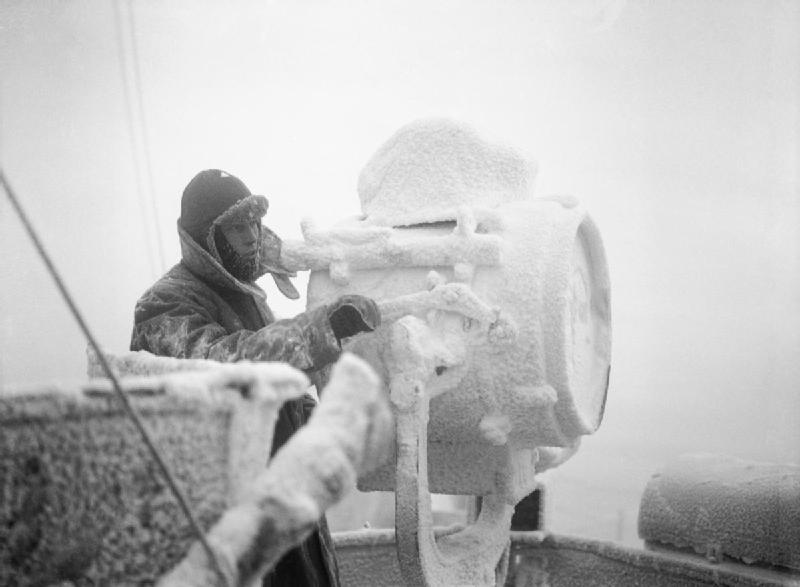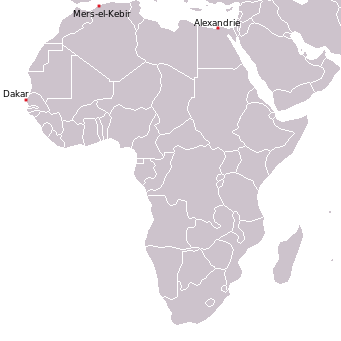|
Terence Lewin, Baron Lewin
Admiral of the Fleet Terence Thornton Lewin, Baron Lewin, (19 November 1920 – 23 January 1999) was a Royal Navy officer. He served in the Second World War and then commanded a destroyer, the Royal yacht, two frigates and an aircraft carrier before achieving higher command. He was First Sea Lord and Chief of the Naval Staff in the late 1970s and in that role he worked hard to secure a decent wage for servicemen and helped win them a 32% pay rise. He went on to be Chief of the Defence Staff during the Falklands War, serving as chief war planner and as Prime Minister Margaret Thatcher's chief advisor during the war. He was also the first Chief of Defence Staff to act as head of the Armed Forces rather than just Chairman of the Chiefs of Staff Committee. Naval career Born the son of Eric Lewin and Maggie Lewin (née Falconer) and educated at The Judd School in Tonbridge, where he was head prefect in 1938, Lewin joined the Royal Navy as a cadet in 1939.Heathcote, p. 155 He was ... [...More Info...] [...Related Items...] OR: [Wikipedia] [Google] [Baidu] |
Dover
Dover () is a town and major ferry port in Kent, South East England. It faces France across the Strait of Dover, the narrowest part of the English Channel at from Cap Gris Nez in France. It lies south-east of Canterbury and east of Maidstone. The town is the administrative centre of the Dover District and home of the Port of Dover. Archaeological finds have revealed that the area has always been a focus for peoples entering and leaving Britain. The name derives from the River Dour that flows through it. In recent times the town has undergone transformations with a high-speed rail link to London, new retail in town with St James' area opened in 2018, and a revamped promenade and beachfront. This followed in 2019, with a new 500m Pier to the west of the Harbour, and new Marina unveiled as part of a £330m investment in the area. It has also been a point of destination for many illegal migrant crossings during the English channel migrant crisis. The Port of Dover provides mu ... [...More Info...] [...Related Items...] OR: [Wikipedia] [Google] [Baidu] |
First Sea Lord And Chief Of The Naval Staff
The First Sea Lord and Chief of the Naval Staff (1SL/CNS) is the military head of the Royal Navy and Naval Service of the United Kingdom. The First Sea Lord is usually the highest ranking and most senior admiral to serve in the British Armed Forces unless either the Chief or Vice-Chief of the Defence Staff are naval officers. Admiral Ben Key was appointed First Sea Lord in November 2021. Originally titled the "Senior Naval Lord to the Board of Admiralty" when the post was created in 1689, the office was re-styled "First Naval Lord" in 1771. The concept of a professional "First Naval Lord" was introduced in 1805, and the title of the office was changed to "First Sea Lord" on the appointment of Sir John Fisher in 1904. Since 1923, the First Sea Lord has been a member of the Chiefs of Staff Committee; he now sits on the Defence Council and the Admiralty Board. [...More Info...] [...Related Items...] OR: [Wikipedia] [Google] [Baidu] |
Malta
Malta ( , , ), officially the Republic of Malta ( mt, Repubblika ta' Malta ), is an island country in the Mediterranean Sea. It consists of an archipelago, between Italy and Libya, and is often considered a part of Southern Europe. It lies south of Sicily (Italy), east of Tunisia, and north of Libya. The official languages are Maltese language, Maltese and English language, English, and 66% of the current Maltese population is at least conversational in the Italian language, Italian language. Malta has been inhabited since approximately 5900 BC. Its location in the centre of the Mediterranean Sea, Mediterranean has historically given it great strategic importance as a naval base, with a succession of powers having contested and ruled the islands, including the Phoenicians and Ancient Carthage, Carthaginians, Romans, Greeks, Arabs, Normans, Aragonese, Knights Hospitaller, Knights of St. John, French, and British, amongst others. With a population of about 516,000 over an ... [...More Info...] [...Related Items...] OR: [Wikipedia] [Google] [Baidu] |
Operation Pedestal
Operation Pedestal ( it, Battaglia di Mezzo Agosto, Battle of mid-August), known in Malta as (), was a British operation to carry supplies to the island of Malta in August 1942, during the Second World War. Malta was a base from which British ships, submarines and aircraft attacked Axis convoys to Libya, during the North African Campaign (1940–1943). From 1940 to 1942, the Axis conducted the Siege of Malta, with air and naval forces. Despite many losses, enough supplies were delivered by the British for the population and military forces on Malta to resist, although it ceased to be an offensive base for much of 1942. The most crucial supply item in Operation Pedestal was fuel, carried by , an American tanker with a British crew. The convoy sailed from Britain on 3 August 1942 and passed through the Strait of Gibraltar into the Mediterranean on the night of The Axis attempt to prevent the fifty ships of the convoy reaching Malta, using bombers, German E-boats, Italian MA ... [...More Info...] [...Related Items...] OR: [Wikipedia] [Google] [Baidu] |
Arctic Convoys Of World War II
The Arctic convoys of World War II were oceangoing convoys which sailed from the United Kingdom, Iceland, and North America to northern ports in the Soviet Union – primarily Arkhangelsk (Archangel) and Murmansk in Russia. There were 78 convoys between August 1941 and May 1945, sailing via several seas of the Atlantic Ocean, Atlantic and Arctic Ocean, Arctic oceans, with two gaps with no sailings between July and September 1942, and March and November 1943. About 1,400 merchant ships delivered essential supplies to the Soviet Union under the Anglo-Soviet Agreement, Anglo-Soviet agreement and US Lend-Lease program, escorted by ships of the Royal Navy, Royal Canadian Navy, and the U.S. Navy. Eighty-five merchant vessels and 16 Royal Navy warships (two cruisers, six destroyers, eight other escort ships) were lost. Nazi Germany's ''Kriegsmarine'' lost a number of vessels including German battleship Scharnhorst, one battleship, three destroyers, 30 U-boats, and many aircraft. The con ... [...More Info...] [...Related Items...] OR: [Wikipedia] [Google] [Baidu] |
Destroyer
In naval terminology, a destroyer is a fast, manoeuvrable, long-endurance warship intended to escort larger vessels in a fleet, convoy or battle group and defend them against powerful short range attackers. They were originally developed in 1885 by Fernando Villaamil for the Spanish NavySmith, Charles Edgar: ''A short history of naval and marine engineering.'' Babcock & Wilcox, ltd. at the University Press, 1937, page 263 as a defense against torpedo boats, and by the time of the Russo-Japanese War in 1904, these "torpedo boat destroyers" (TBDs) were "large, swift, and powerfully armed torpedo boats designed to destroy other torpedo boats". Although the term "destroyer" had been used interchangeably with "TBD" and "torpedo boat destroyer" by navies since 1892, the term "torpedo boat destroyer" had been generally shortened to simply "destroyer" by nearly all navies by the First World War. Before World War II, destroyers were light vessels with little endurance for unat ... [...More Info...] [...Related Items...] OR: [Wikipedia] [Google] [Baidu] |
Attack On Mers-el-Kébir
The Attack on Mers-el-Kébir (Battle of Mers-el-Kébir) on 3 July 1940, during the Second World War, was a British naval attack on neutral French Navy ships at the naval base at Mers El Kébir, near Oran, on the coast of French Algeria. The attack was the main part of Operation Catapult, a British plan to neutralise or destroy neutral French ships to prevent them from falling into German hands after the Allied defeat in the Battle of France. The British bombardment of the base killed 1,297 French servicemen, sank a battleship and damaged five other ships, for a British loss of five aircraft shot down and two crewmen killed. The attack by air and sea was conducted by the Royal Navy, after France had signed armistices with Germany and Italy, coming into effect on 25 June. Of particular significance to the British were the five battleships of the and es and the two fast battleships of the , the second largest force of capital ships in Europe after the Royal Navy. The British Wa ... [...More Info...] [...Related Items...] OR: [Wikipedia] [Google] [Baidu] |
HMS Ashanti
Two ships of the Royal Navy have been named HMS ''Ashanti'' after the Ashanti people The Asante, also known as Ashanti () are part of the Akan ethnic group and are native to the Ashanti Region of modern-day Ghana. Asantes are the last group to emerge out of the various Akan civilisations. Twi is spoken by over nine million As .... * was a destroyer launched in 1937 and sold for breaking up in 1949. * was a frigate launched in 1959. She was expended as a target in 1988. {{DEFAULTSORT:Ashanti, Hms Royal Navy ship names ... [...More Info...] [...Related Items...] OR: [Wikipedia] [Google] [Baidu] |
Battleship
A battleship is a large armored warship with a main battery consisting of large caliber guns. It dominated naval warfare in the late 19th and early 20th centuries. The term ''battleship'' came into use in the late 1880s to describe a type of ironclad warship,Stoll, J. ''Steaming in the Dark?'', Journal of Conflict Resolution Vol. 36 No. 2, June 1992. now referred to by historians as pre-dreadnought battleships. In 1906, the commissioning of into the United Kingdom's Royal Navy heralded a revolution in the field of battleship design. Subsequent battleship designs, influenced by HMS ''Dreadnought'', were referred to as "dreadnoughts", though the term eventually became obsolete as dreadnoughts became the only type of battleship in common use. Battleships were a symbol of naval dominance and national might, and for decades the battleship was a major factor in both diplomacy and military strategy.Sondhaus, L. ''Naval Warfare 1815–1914'', . A global arms race in battleship con ... [...More Info...] [...Related Items...] OR: [Wikipedia] [Google] [Baidu] |
HMS Vindictive (1918)
HMS ''Vindictive'' was a warship built during the First World War for the Royal Navy (RN). Originally designed as a heavy cruiser and laid down under the name ''Cavendish'', she was converted into an aircraft carrier while still being built. Renamed in 1918, she was completed a few weeks before the end of the war and saw no active service with the Grand Fleet. The following year she participated in the British campaign in the Baltic against the Bolsheviks, during which her aircraft made numerous attacks against the naval base at Kronstadt. ''Vindictive'' returned home at the end of the year and was placed in reserve for several years before her flight decks were removed and she was reconverted back into a cruiser. The ship retained her aircraft hangar and conducted trials with an aircraft catapult before she was sent to the China Station in 1926. A year after her return in 1928, she was again placed in reserve. ''Vindictive'' was demilitarized and converted into a training sh ... [...More Info...] [...Related Items...] OR: [Wikipedia] [Google] [Baidu] |
Cadet
A cadet is an officer trainee or candidate. The term is frequently used to refer to those training to become an officer in the military, often a person who is a junior trainee. Its meaning may vary between countries which can include youths in voluntary youth organisations. Usage by country Antigua and Barbuda The Antigua and Barbuda Cadet Corps consists of students between the ages of 12 and 19. It Is a voluntary youth organization, sponsored by the government and people of Antigua & Barbuda that acquires its membership from the Secondary School. The main objective is to provide training and personal development to the youths through paramilitary activities and also embrace community activities. The training is geared to inspire young men and woman to become model citizens. Emphasis during training is often based on discipline, loyalty, leadership and good citizenry. Presently, the cadet corps has 200 active members and falls under the direct command of Colonel Glyne ... [...More Info...] [...Related Items...] OR: [Wikipedia] [Google] [Baidu] |






